Muscovy Duck
- February 19, 2024
- 0 comment
The Muscovy duck, scientifically known as Cairina moschata, is a captivating waterfowl species that boasts a distinct appearance and intriguing behaviors. Originating from the tropical regions of Mexico, Central, and South America, these ducks have a unique charm that sets them apart from other duck breeds. One of their most notable features is the presence of a prominent caruncle, a fleshy growth, on their faces, which can be red or black in color and more pronounced in males.
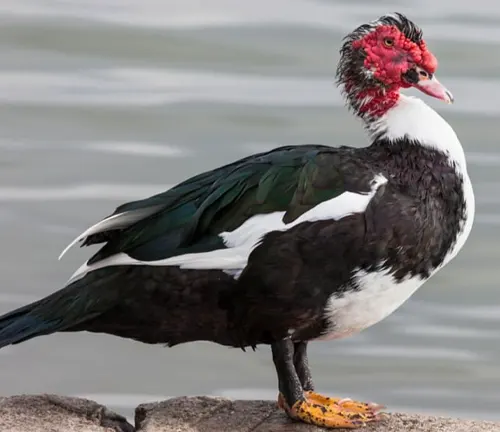
Their plumage comes in various shades, including black, white, chocolate, and iridescent greens, adding to their allure. Muscovy ducks are renowned for their adaptability, thriving in diverse environments from swamps and wetlands to urban parks and farmlands. They are not only skilled flyers but also adept swimmers, making them well-suited for both terrestrial and aquatic habitats. Beyond their natural habitat, Muscovy ducks have been domesticated for centuries, valued for their meat, eggs, and pest-control abilities. Whether in the wild or as companions in domestic settings, Muscovy ducks continue to fascinate and enchant observers with their unique characteristics and captivating presence.
| Attribute | Description |
|---|---|
| Scientific Name | Cairina moschata |
| Common Name | Muscovy Duck |
| Family | Anatidae |
| Origin | Mexico, Central, and South America |
| Average Lifespan | 10-15 years |
| Size | Large-bodied |
| Caruncle Color | Red or black |
| Plumage Colors | Black, white, chocolate, iridescent green |
| Habitat | Tropical forests, swamps, wetlands |
| Adaptability | Highly adaptable to various environments |
| Flight Capability | Excellent flyers |
| Social Structure | Generally solitary or small groups, pairs during breeding season |
| Diet | Omnivorous; consumes aquatic plants, insects, small fish, crustaceans, agricultural crops |
| Domestication | Domesticated for meat, eggs, pest control |
| Behavior | Docile, calm demeanor; non-aggressive towards humans when properly socialized |
| Conservation Status | Not endangered; face threats such as habitat loss, pollution, hunting |
| Cultural Significance | Revered in folklore, mythology; symbolizes fertility, prosperity, good fortune |
Muscovy ducks, scientifically known as Cairina moschata, are unique waterfowl species native to Mexico, Central, and South America. They belong to the family Anatidae and are distinct from other duck breeds due to their origin and physical characteristics.
Appearance and Physical Characteristics
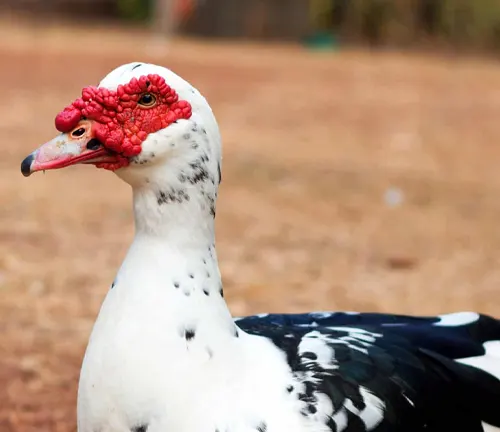
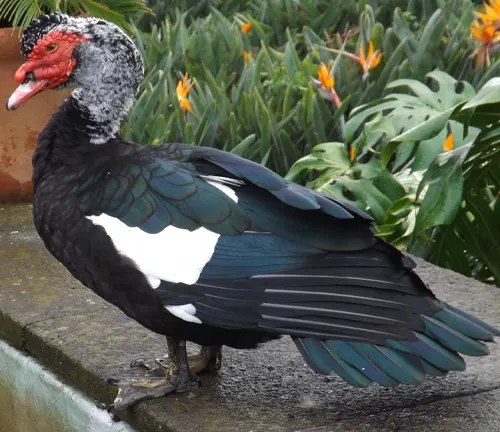
The appearance and physical characteristics of Muscovy ducks are distinct and unique among waterfowl species. These ducks are notable for their large-bodied stature, featuring a robust build with broad chests and sturdy legs. One of the most striking features of Muscovy ducks is the presence of a prominent caruncle on their faces. This caruncle, which is a fleshy growth, can vary in color between individuals, ranging from vibrant red to dark black. It is typically more pronounced in males than females. Additionally, Muscovy ducks have striking plumage that comes in a variety of colors, including black, white, chocolate, and iridescent greens. Their feathers may have a glossy sheen, adding to their overall appeal. Muscovy ducks also have strong claws and broad wings, which enable them to perch in trees and navigate various terrains with ease. Overall, their unique appearance and physical characteristics make Muscovy ducks easily recognizable and captivating to observe in both wild and domestic settings.
Natural Habitat and Distribution
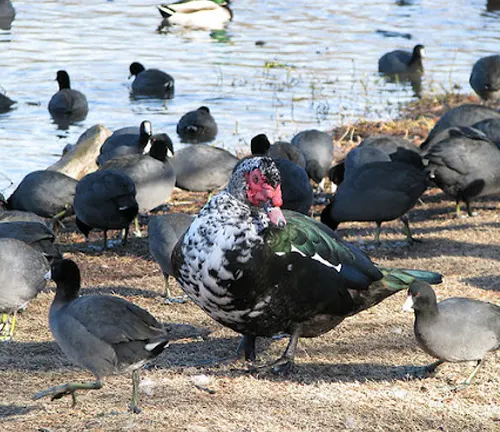
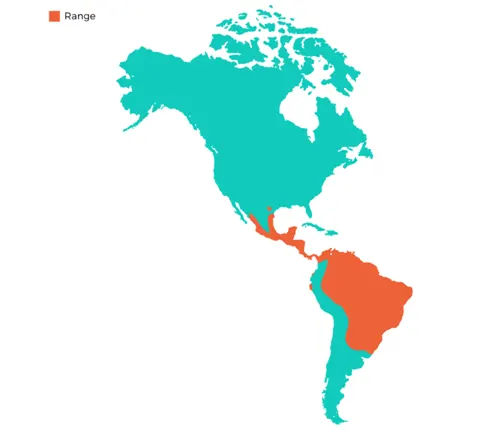
Muscovy ducks are native to the tropical regions of Mexico, Central America, and South America. They have a diverse natural habitat that includes various wetland habitats such as swamps, marshes, lakes, and rivers, as well as tropical forests. These ducks are highly adaptable and can thrive in both freshwater and brackish water environments. In their natural habitat, Muscovy ducks can be found in densely vegetated areas near water bodies, where they have access to food sources such as aquatic plants, insects, small fish, and crustaceans. Over time, due to human intervention and domestication, Muscovy ducks have been introduced to regions beyond their native range, including North America, Europe, Asia, and other parts of the world. Today, they can be found in a variety of habitats, from urban parks and suburban ponds to rural farmsteads and agricultural areas. Despite their adaptability to different environments, Muscovy ducks still prefer habitats with ample water sources and vegetation for foraging and nesting.
Behavior and Social Structure
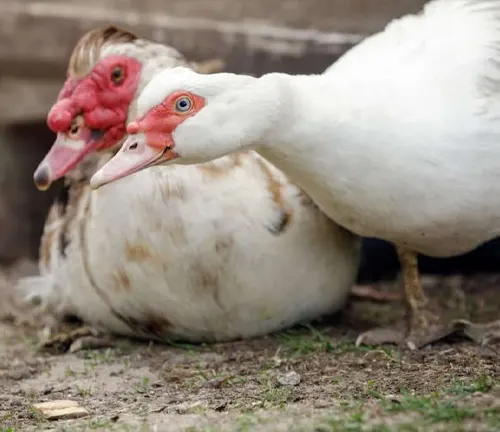

Muscovy ducks exhibit interesting behavior and have a distinct social structure that sets them apart from other duck species. These ducks are known for their calm and docile demeanor, making them popular among bird enthusiasts and hobbyists. In their natural habitat, Muscovy ducks are generally solitary or form small groups, although they may come together in larger flocks during migration or at communal feeding areas. During the breeding season, which typically occurs in the spring, Muscovy ducks pair up to mate, forming monogamous bonds for the duration of the breeding season. Males engage in elaborate courtship displays to attract females, which may include head bobbing, wing flapping, and vocalizations. Once paired, the male and female work together to select a suitable nesting site and raise their offspring. Despite their relatively solitary nature, Muscovy ducks are also highly social animals and engage in various forms of communication with each other, including vocalizations, body language, and tactile interactions. They may also exhibit hierarchical behavior within their social groups, with dominant individuals asserting their status through displays of aggression or dominance. Overall, the behavior and social structure of Muscovy ducks reflect their adaptable and resilient nature, allowing them to thrive in diverse environments and form complex social relationships with conspecifics.
Diet and Feeding Habits
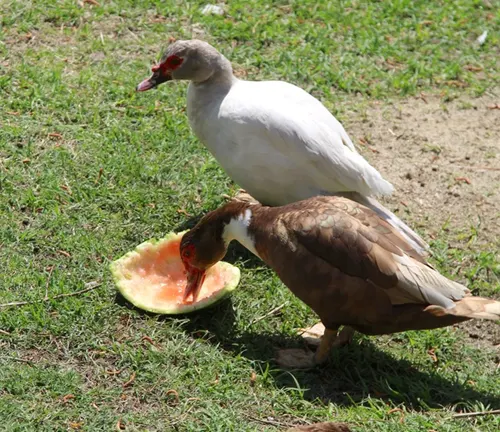
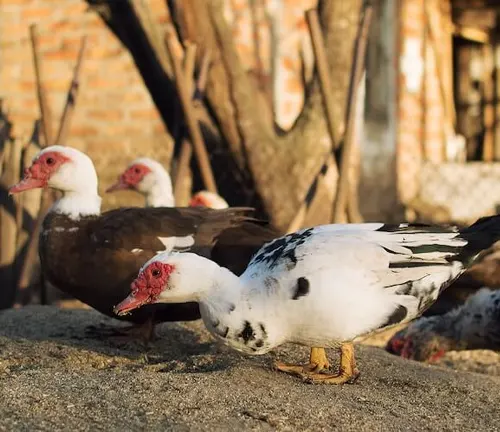
Muscovy ducks have an omnivorous diet, meaning they consume a wide variety of foods from both plant and animal sources. In their natural habitat, Muscovy ducks primarily feed on aquatic plants, including water lilies, duckweed, and algae, which they forage for in wetland habitats such as swamps, marshes, and lakes. They also feed on a variety of insects, small fish, crustaceans, and mollusks found in and around water bodies. Muscovy ducks are skilled dabbling ducks, meaning they tip their bodies forward to reach underwater vegetation and prey items while keeping their tails up in the air. In addition to their natural diet, Muscovy ducks may also consume agricultural crops such as grains, fruits, and vegetables, making them both beneficial and sometimes problematic for farmers. In domestic settings, Muscovy ducks are often provided with a balanced diet consisting of commercial duck feed supplemented with fresh greens, vegetables, and occasional treats. Proper nutrition is essential for the health and well-being of Muscovy ducks, and owners should ensure they have access to clean water and a varied diet to meet their nutritional needs.
Reproduction and Nesting Behavior
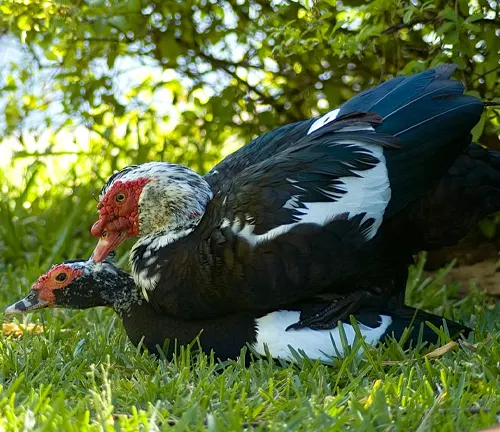
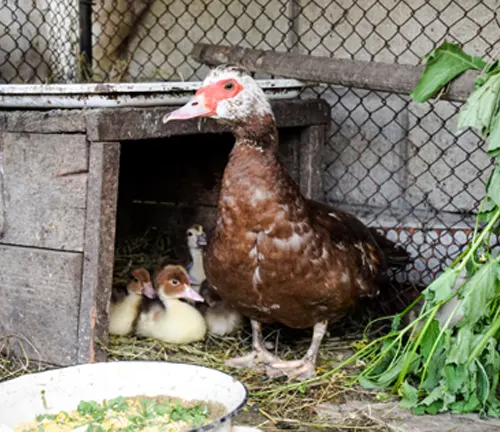
Reproduction and nesting behavior are significant aspects of the life cycle of Muscovy ducks, particularly during the breeding season. Muscovy ducks typically breed in the spring and early summer months, although the exact timing may vary depending on factors such as geographic location and environmental conditions. During this time, males engage in elaborate courtship displays to attract females, which may include vocalizations, head bobbing, and wing flapping. Once paired, the male and female Muscovy ducks work together to select a suitable nesting site, usually near water bodies such as ponds, lakes, or rivers.
The female constructs the nest using various materials such as twigs, leaves, and grass, creating a shallow depression lined with down feathers for insulation. Muscovy ducks are known for their resourcefulness and may even use man-made structures such as nesting boxes or hollow trees as nesting sites. Once the nest is complete, the female lays a clutch of eggs, typically ranging from 8 to 16 eggs, although clutch sizes may vary.
The female diligently incubates the eggs for about a month, rarely leaving the nest except to feed and drink. During this incubation period, the male may stand guard nearby to protect the nest from predators and other intruders. After the eggs hatch, the female cares for the ducklings, leading them to water and teaching them to forage for food. Muscovy ducklings grow rapidly and are precocial, meaning they are relatively independent and able to feed themselves shortly after hatching. Overall, reproduction and nesting behavior are crucial components of Muscovy duck biology, ensuring the survival and growth of their offspring in the wild
Domestication of Muscovy Ducks
The domestication of Muscovy ducks has a long and fascinating history dating back thousands of years. Originally native to Mexico, Central America, and South America, Muscovy ducks were first domesticated by indigenous peoples in these regions for their meat, eggs, and feathers. These early domestication efforts likely began as a means of food production and resource utilization, as Muscovy ducks provided a reliable source of protein and other valuable materials.
Over time, Muscovy ducks were introduced to other parts of the world through trade and exploration, spreading their domesticated populations across continents. European explorers and colonists encountered Muscovy ducks in the Americas and brought them back to Europe, where they were further bred and developed for various purposes.
Uses of Muscovy Ducks in Agriculture
Muscovy ducks play several important roles in agriculture, making them valuable assets on farms and homesteads around the world. Some of the key uses of Muscovy ducks in agriculture include:
Meat Production
Muscovy ducks are prized for their flavorful and lean meat, which is considered a delicacy in many cuisines. Their meat is darker and richer than that of other duck breeds, with a taste often likened to that of roast beef or veal. Muscovy ducks are commonly raised for meat production on small-scale farms and homesteads, providing a sustainable source of high-quality protein for human consumption.
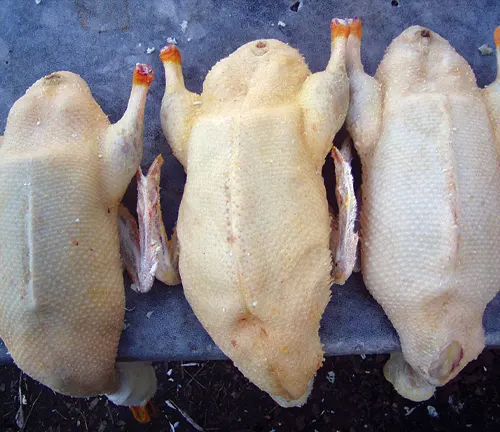
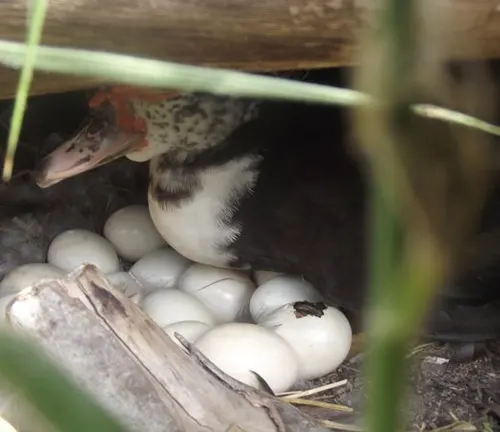
Egg Production
Muscovy ducks also lay delicious and nutritious eggs, which are larger and richer in flavor than chicken eggs. While Muscovy ducks may not lay eggs as frequently as chickens, their eggs are highly prized by culinary enthusiasts and chefs for their culinary versatility and superior taste. Muscovy duck eggs are often used in baking, cooking, and other culinary applications.
Pest Control
Muscovy ducks are natural foragers with a voracious appetite for insects, slugs, snails, and other pests. Their diet includes a wide variety of invertebrates and small vertebrates, making them effective natural pest controllers in agricultural settings. By allowing Muscovy ducks to roam freely in gardens, orchards, and fields, farmers can reduce reliance on chemical pesticides and promote ecological balance.
Fertilizer Production
Muscovy ducks produce nutrient-rich manure that can be used to fertilize crops and improve soil fertility. Duck manure is high in nitrogen, phosphorus, and potassium, essential nutrients for plant growth and development. By incorporating Muscovy duck manure into compost or applying it directly to fields, farmers can enhance soil health and increase crop yields in a sustainable and environmentally friendly manner.
Weed Management
Muscovy ducks are effective weeders, capable of consuming a wide variety of weeds and unwanted vegetation. By allowing Muscovy ducks to graze in pastures, orchards, and vineyards, farmers can control weed growth and minimize the need for mechanical or chemical weed control methods. This natural weed management approach reduces labor costs and promotes soil health without the use of synthetic herbicides.
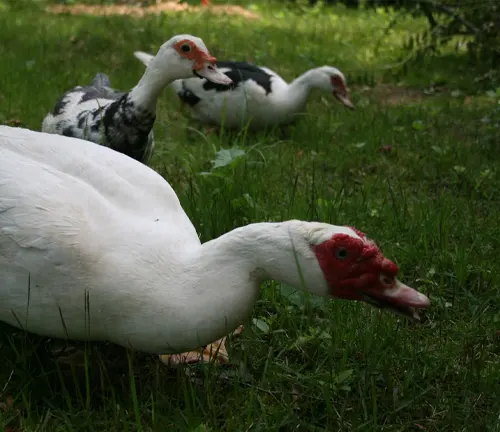
Conservation Status and Threats
The conservation status of Muscovy ducks varies depending on their location and populations. In their native range of Mexico, Central America, and South America, Muscovy ducks are considered to be of least concern by the International Union for Conservation of Nature (IUCN). However, certain localized populations may face threats due to habitat loss, pollution, hunting, and competition with introduced species.
In regions where Muscovy ducks have been introduced outside of their native range, such as North America, Europe, and Asia, they are often considered invasive species. While they may thrive in these new environments and provide benefits such as pest control, their presence can also have negative impacts on native ecosystems and species. Invasive Muscovy ducks may compete with native waterfowl for resources, disrupt local ecosystems, and contribute to the spread of diseases.
Habitat loss and degradation are significant threats to Muscovy ducks in both their native and introduced ranges. Wetland destruction, urbanization, and agricultural expansion have led to the loss of critical habitat for Muscovy ducks, reducing the availability of suitable nesting sites and foraging areas. Pollution from agricultural runoff, industrial activities, and urban development can also degrade water quality and pose health risks to Muscovy ducks and other aquatic species.
Different Species
White Muscovy Duck
These ducks have predominantly white plumage with occasional patches of other colors.

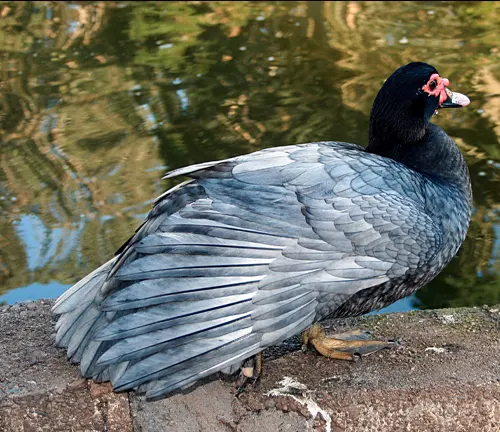
Blue Muscovy Duck
Blue Muscovy ducks have a bluish-gray hue to their plumage, creating a unique appearance.
Chocolate Muscovy Duck
This breed showcases rich chocolate-brown plumage, often with iridescent undertones.

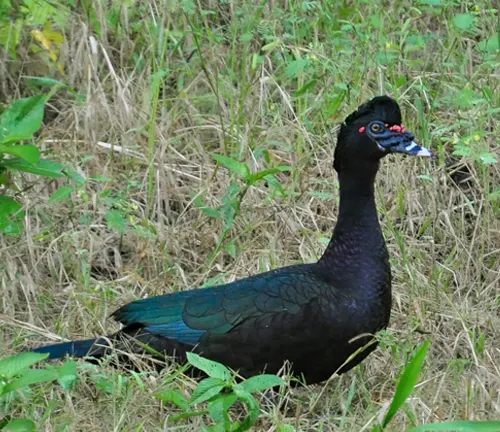
Black Muscovy Duck
Black Muscovy ducks have entirely black plumage, giving them a striking and elegant appearance.
Barred Muscovy Duck
Barred Muscovy ducks feature a pattern of alternating light and dark stripes or bars across their feathers.
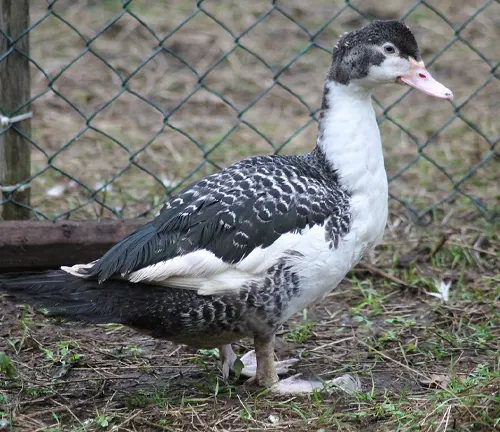
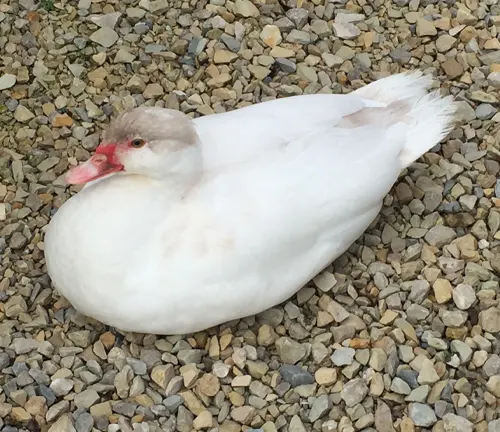
Buff Muscovy Duck
Buff Muscovy ducks have a soft, creamy buff-colored plumage, creating a warm and inviting appearance.
Crested Muscovy Duck
Crested Muscovy ducks have a genetic mutation that results in a distinctive crest or tuft of feathers on their heads.
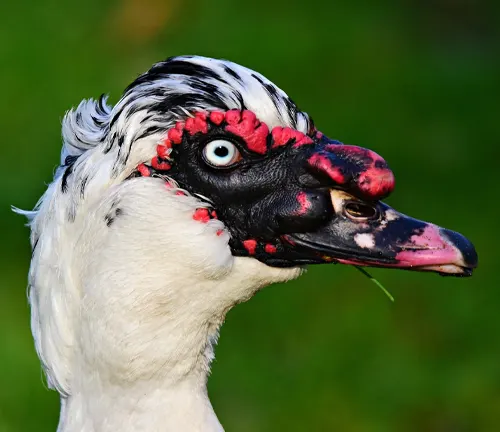
Frequently Asked Questions (FAQs)
- Can Muscovy ducks fly?
Yes, Muscovy ducks are excellent flyers and can soar gracefully through the air. They are known for their strong wing muscles and can travel long distances if needed. - Do Muscovy ducks need water to swim in?
While Muscovy ducks enjoy swimming and bathing, they don’t require large bodies of water like ponds or lakes to thrive. However, providing them with a shallow water source, such as a kiddie pool or shallow basin, is beneficial for their overall health and well-being. - Are Muscovy ducks noisy?
Compared to other duck breeds, Muscovy ducks are relatively quiet. They do not produce loud quacking sounds but may make soft hissing or cooing noises, especially during courtship or communication with their flock. - How often do Muscovy ducks lay eggs?
Muscovy ducks typically lay eggs in the spring and early summer months, with peak egg production occurring during this time. The exact frequency of egg-laying can vary depending on factors such as age, health, and environmental conditions. - Can Muscovy ducks live with other duck breeds?
Muscovy ducks can coexist peacefully with other duck breeds, provided they have enough space and resources. However, it’s essential to introduce them gradually and monitor their interactions to prevent aggression or territorial disputes. - Do Muscovy ducks need shelter?
While Muscovy ducks are hardy and can withstand various weather conditions, providing them with shelter, such as a duck house or sheltered area, is beneficial, especially during extreme temperatures or inclement weather. - How can I tell the gender of a Muscovy duck?
Determining the gender of a Muscovy duck can be challenging, especially in juveniles. However, adult males typically have larger caruncles and more pronounced facial features than females. Additionally, males tend to be larger in size and may exhibit more aggressive behavior during the breeding season. - Do Muscovy ducks need a mate to breed?
While Muscovy ducks are social animals and may pair up during the breeding season, they do not necessarily require a mate to breed successfully. Females can lay fertile eggs without mating, although the presence of a male may increase the likelihood of successful breeding. - Are Muscovy ducks messy?
Like most waterfowl, Muscovy ducks can be messy, especially around water sources. They may create mud puddles or scatter feed while foraging. However, providing proper habitat management and regular cleaning can help minimize messiness. - Can Muscovy ducks be kept in urban areas?
Yes, Muscovy ducks can adapt well to urban environments and are commonly found in parks, residential areas, and farmsteads. However, it’s essential to check local regulations regarding keeping ducks and ensure adequate space and provisions for their care.


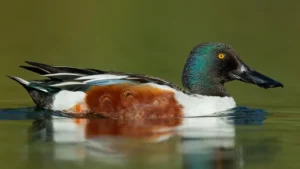

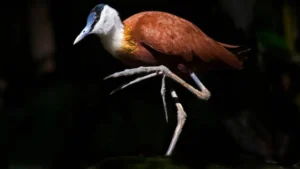
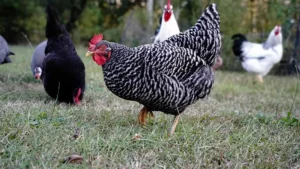

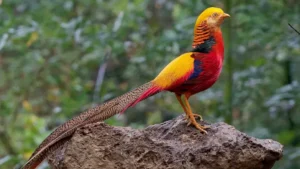
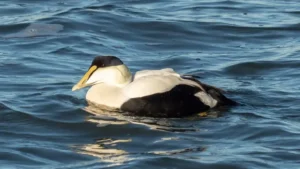
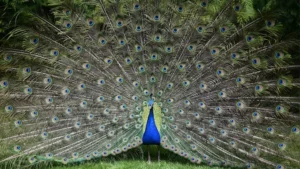


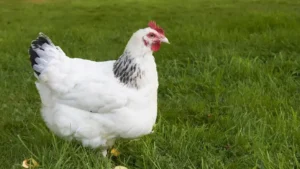
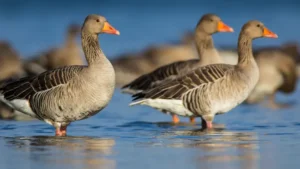
Leave your comment